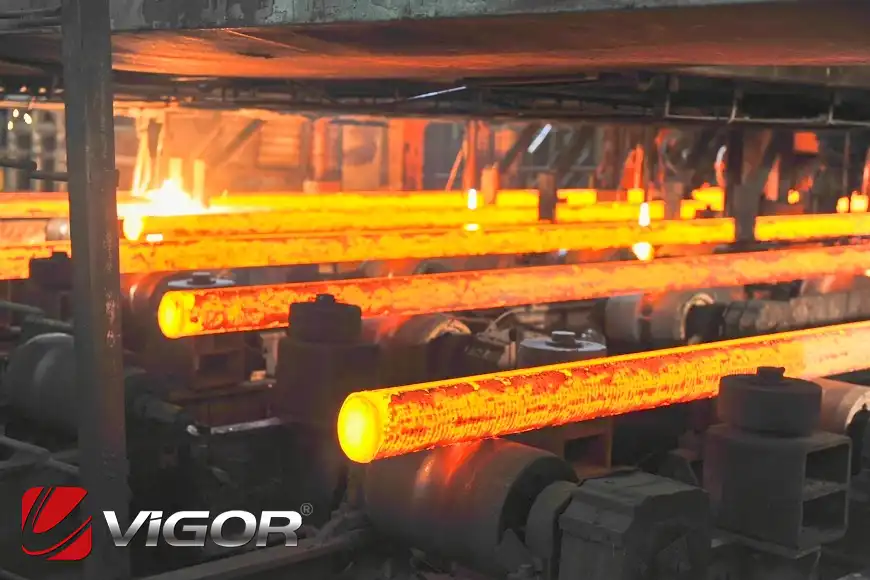
Knowledge
Continuous Casting
Continuous casting is widely used in steel production, nearing 95% of all products from strip and plate mills. The process is also widely used for non-ferrous metals and alloys. It is crucial in supplying the raw materials for most downstream manufacturing processes, including rolling, forging, and extrusion. It converts semi-finished products into various final profiles and cut lengths. This article introduces continuous casting, its applications and advantages, and its importance in certain areas of both raw material processing and finished or near-finished product manufacture.
What Is Continuous Casting?
Continuous casting is a metal casting process that produces continuous lengths of metal, with a constant (2D) cross-section. It's a highly efficient method for converting molten metal into long lengths of semi-finished product of a relatively small, potentially complex cross-section. Put simply… the process introduces molten metal into a mold that has the required profile. It allows the metal to solidify while continuously being pulled or pushed through the mold. Internal hollows of moderate precision can be seamlessly formed by the suspension of core features in the molten and early-cooling zone. The most common form has the casting tool mounted vertically on a tower, and the product is drawn from below the tool by rollers. However, increasingly, a horizontal system is being used: The tool is still mounted vertically, but rollers below it feed the not-yet fully hard profile through a 90° turn to run horizontally away.
Why Is Continuous Casting Also Called as Lost Wax Process?
No, continuous casting is not called a lost-wax process. The lost-wax process, instead, is also known as investment casting, precision casting, or cire perdue.
How Does Continuous Casting Differ From Other Types of Casting?
Continuous casting differs in most regards from all other casting types. While it does use a cavity to form liquid metal into a solid that reflects the shape of the cavity, it differs in almost every detail from all other casting processes. All other casting methods produce 3D profiles, or a 2D profile of predetermined lengths as a finished or partially finished object. In general, casting processes use a closed (or sometimes upper side open) cavity to form a part that accurately reflects this volume.
What Is the Importance of Continuous Casting in Manufacturing?
Continuous casting is of overwhelming importance in the manufacturing of high-quality and continuous-length bars and plate stock for follow-on manufacturing processes, particularly in the steel industry. It offers significant commercial benefits in cost reduction, quality, and energy consumption, compared with the more traditional open sand casting of billets that are then heavily hot and cold rolled to required profiles.
What Are the Industries That Use Continuous Casting?
Some industries that use continuous casting are the: electrical, automotive, construction, and aerospace sectors. Continuous casting is widely employed in the production of prepared/processed raw materials for post-process finishing by forging, rolling, or machining. It is used to produce aluminum billets, slabs, and other shapes. These are later processed into products such as: sheets, plates, extrusions, and aluminum alloys for various applications. Continuous casting is employed to create copper rods, tubes, and other shapes for use in electrical applications, plumbing, and industrial components. This technique initiates most of the steel bulk raw materials used in the manufacturing of automotive components. The aerospace sector also uses continuous casting for raw materials of more exotic materials. Examples are the production of jet engine components including turbine blades.
How Does Continuous Casting Work?
Continuous casting is a metal manufacturing process that outputs semi-finished products like billets, slabs, and rods with a consistent cross-section. The key principle of the approach is to maintain a consistent flow of molten metal through the mold while ensuring gradual solidification to achieve an optimized and homogeneous structure.
Continuous casting uses a water-cooled 2D profile cavity that is mounted vertically and open at the top and bottom. This open channel accepts molten metal from a tundish feeder. The charge then cools and solidifies as it passes through the length of the water-cooled tool. As it emerges from the lower end of the casting tool, its profile is set and hardened enough to retain both shape and dimensional accuracy.
This allows a continuous pour of molten metal to enter the cavity and feed through it as it cools and solidifies. In this way, the partially cooled cast can be pulled through the cavity at a rate that matches the liquid introduction at the other end of the tool. In vertical systems, the cast travels downwards to cutters that crop off the form to the required lengths. In more up-to-date horizontal setups, the cast is rolled through a 90° turn to run out horizontally and complete the cooling/hardening before cropping.
Vigor boasts a highly skilled mechanical department and seasoned mechanical engineers who possess extensive experience in the forging and casting sectors. This expertise underpins our commitment to delivering products of exceptional quality. Our team at Vigor is adept at offering a range of casting processes, tailored to your specific needs. Moreover, our engineers provide expert guidance, drawing on their wealth of knowledge in design and manufacturing. Should you be seeking top-tier casting and forging machinery products, we invite you to reach out to us. At Vigor, you'll find not just the finest products but also the most comprehensive technical support available.




